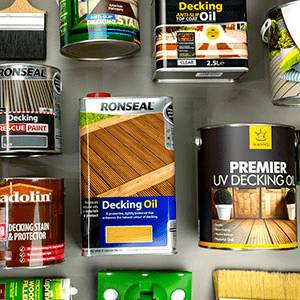Railway Sleeper Treatment FAQ's
What product(s) should I use to protect my railway sleepers?
To allow railway sleepers to turn grey or silver over time, whilst protecting them from the elements, we recommend using a clear wood oil or decking oil which doesn't contain any UV filters. This will allow the appearance of the wood to age while keeping it nourished, supple and water-resistant, helping to protect the sleepers from water and frost damage.
Can I buy Creosote to treat my reclaimed railway sleepers?
Traditional Creosote is no longer available to the general public and can only be supplied to farmers and other industrial businesses. While we do not stock Creosote, we do stock a substitute called Creosolve which is a more user and environmentally friendly version of Creosote. Barrettine Creosolve is available in both a light and dark brown formula, and it is perfectly suited for use on railway sleepers.
Need advice on how to protect wooden sleepers?
The type of wood treatment required to preserve and protect railway sleepers depends on the type of sleeper and the desired effect. Reclaimed Oak or other exotic hardwood railway sleepers are likely to last for at least 25 years as long as they are not buried in the ground or submerged in water. Left untreated they are likely to just turn silver or grey over time as the tanning in the surface fibres of the timber are bleached out by the sun and removed by water. For many, the grey, weathered appearance is exactly what is required. If you're looking to retain the colour for longer, a clear decking oil with UV filters will help. The oil will nourish the wood and repel water, helping to prevent the wood from cracking and splitting over time. It's worth noting that some reclaimed railway sleepers can go very dark, almost black, when a clear wood oil is applied.
New reproduction sleepers are available in both Oak and Pine. Oak reproduction sleepers will naturally last longer than their softwood alternative. Both types should be treated with an exterior wood preservative on all sides prior to installation and paying special attention to any sawn ends. They can then be treated with a clear or coloured decking oil, again preferably on all sides and cut ends prior to installation.
Do railway sleepers need to be treated and preserved?
This depends on the type of railway sleepers you have. Reclaimed railway sleepers are usually made from high grade Oak or other dense exotic hardwood, and have usually been treated with Creasote, Tar or some other industrial grade preservative. Reclaimed railway sleepers are likely to last for decades above ground if left untreated. This said, applying a wood preservative or wood oil will help to protect the timber for longer.
Reproduction railway sleepers are usually made from Oak or Pine. They can be bought untreated and pre-preserved. It is worth checking this with the supplier if you are unsure. A new, preserved sleeper will have a greenish brown tinge much like a new fence panel.
New reproduction sleepers will benefit from the use of a wood preserver and an exterior wood oil such as Manns Premier UV Decking Oil. Where possible, treat all sides and cut ends prior to installation.
Can I treat railway sleepers that have started to rot?
This is a difficult question to answer without further information. Are they softwood or hardwood reproduction railway sleepers or genuine reclaimed sleepers? How bad is the wood rot?
If the wood has started to rot there's probably little that can be done to stop this. You may be able to slow down the inevitable and improve the appearance of the wood by removing as much of the rotted wood as possible, then applying a wood hardener like Ronseal Wet Rot Wood Hardener to the affected areas. Repair any holes, gaps or uneven surfaces with a suitable exterior wood filler and treat all sound, good wood with an exterior wood preservative. To preserve the sleepers further, we would recommend treating them with an exterior wood oil or decking oil, ideally twice a year in Spring and Autumn. This will help to repel water and prevent water ingress, the main cause of wood rot.
Unfortunately, if the sleepers are being used to retain soil and the soil is in contact with the wood, there's probably not much that can be done to protect the soil facing surface.
I want to use Cuprinol Ducksback on my softwood sleepers in the garden. I want to apply it with a roller. Is there a particular type I should use?
Cuprinol Ducksback can be used on rough sawn timber. If the timber has been planned or has a smooth surface then the product may not adhere properly. Cuprinol advise brush application for the best finish.
Working in the direction of the grain, allow 2-4 hours between coats, adding more coats for a stronger, more intensive colour finish.
A roller could be used, but may impact on uptake and when applying on the recommended rough sawn timber, may have issues such as snagging.
Can railway sleepers be used to make garden furniture?
This depends on what type of railway sleepers you have. Traditional reclaimed railway sleepers cannot be used for any form of seating or tables as the wood and any splinters can be toxic. However, new reproduction, untreated Pine and Oak railway sleepers are fine as long as they are not treated with a product that's unsuitable for skin or food contact.
Railway Sleeper Treatments
Related Railway Sleeper blog posts
Disclaimer: Whilst every attempt has been made to provide product information that is as accurate as possible, it's important to clarify that trees and the wood that they produce can be affected by many factors. For example, the same species of tree grown in the same wood, even in close proximity, will be affected by age along with the amount of sunlight and water they receive. Other naturally occurring biological and environmental factors will also influence the density and grain of the wood as well as the moisture and oil content of the timber. No two trees are the same, meaning each piece of wood has the potential to look and react differently to the same wood finish. For example, product adhesion, colour variations, absorption rates and sheen levels. It is for this reason that we always strongly recommend carrying out test areas before starting any project


